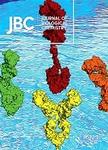版权所有:内蒙古大学图书馆 技术提供:维普资讯• 智图
内蒙古自治区呼和浩特市赛罕区大学西街235号 邮编: 010021

作者机构:Duke Univ Med Ctr Dept Pathol & Microbiol Durham NC 27710 USA Washington Univ Dept Biol St Louis MO 63130 USA Azabu Univ Sch Vet Med Dept Vet Med Kanagawa 229 Japan Washington Univ Sch Med Dept Pathol St Louis MO 63110 USA Washington Univ Sch Med Dept Med St Louis MO 63110 USA
出 版 物:《JOURNAL OF BIOLOGICAL CHEMISTRY》 (生物化学杂志)
年 卷 期:1999年第274卷第9期
页 面:5797-5809页
核心收录:
学科分类:0710[理学-生物学] 071010[理学-生物化学与分子生物学] 07[理学]
基 金:NIAID NIH HHS [AI 35678] Funding Source: Medline NIDDK NIH HHS [DK 508141] Funding Source: Medline
主 题:黏着素 细菌/化学 黏着素 细菌/遗传学 黏着素 细菌/生理学 黏着素 大肠杆菌 氨基酸序列 细菌黏附 碱基序列 细胞系 DNA引物 菌毛蛋白质类 纤毛 细菌/生理学 肠/细胞学 肠/微生物学 肠/超微结构 显微镜检查 电子/方法 分子序列数据 诱变 定点 蛋白质生物合成 重组融合蛋白质类/遗传学 重组融合蛋白质类/代谢 鼠伤寒沙门菌/生理学 序列同源性 氨基酸 向性 尿道上皮/细胞学 尿道上皮/微生物学 动物 小鼠
摘 要:Salmonella typhimurium exhibits a distinct tropism for mouse enterocytes that is linked to their expression of type 1 fimbriae, The distinct binding traits of Salmonella type 1 fimbriae is also reflected in their binding to selected mannosylated proteins and in their ability to promote secondary bacterial aggregation on enterocyte surfaces. The determinant of binding in Salmonella type I fimbriae is a 35-kDa structurally distinct fimbrial subunit, FimHs, because inactivation of fimHs abolished binding activity in the resulting mutant without any apparent effect on fimbrial expression. Surprisingly, when expressed in the absence of other fimbrial components and as a translational fusion protein with MalE, FimHs failed to demonstrate any specific binding tropism and bound equally to all cells and mannosylated proteins tested. To determine if the binding specificity of Salmonella type 1 fimbriae was determined by the fimbrial shaft that is intimately associated with FimHs, we replaced the amino-terminal half of FimHs with the corresponding sequence from Escherichia coli FimH (FimHE) that contains the receptor binding domain of FimHE, The resulting hybrid fimbriae bearing FimHES on a Salmonella fimbrial shaft exhibited binding traits that resembled that of Salmonella rather than E, coli fimbriae, Apparently, the quaternary constraints imposed by the fimbrial shaft on the adhesin determine the distinct binding traits of S. typhimurium type 1 fimbriae.